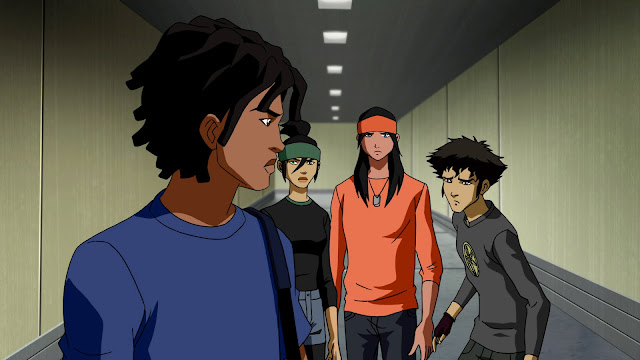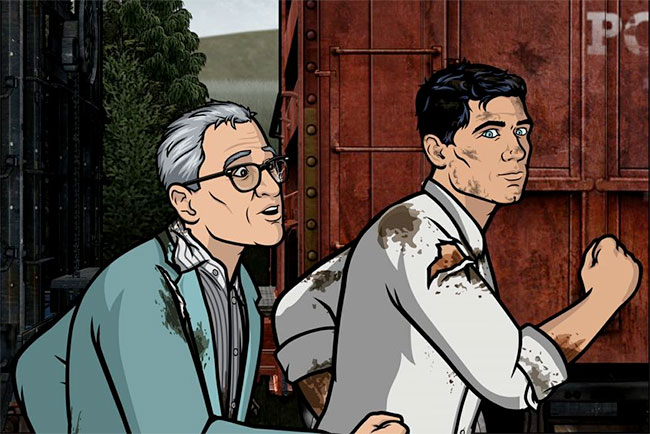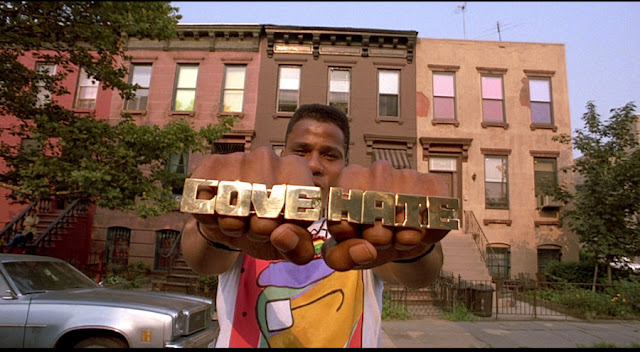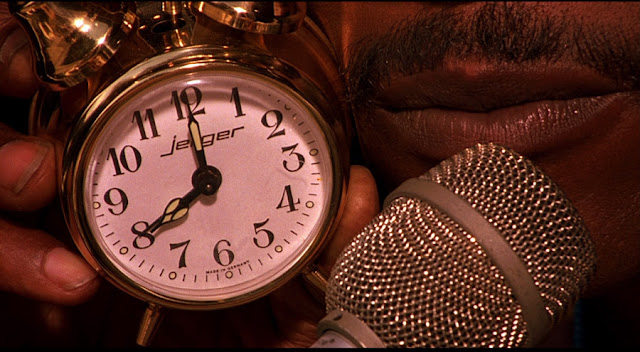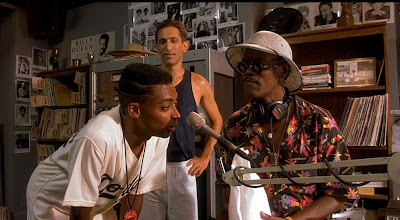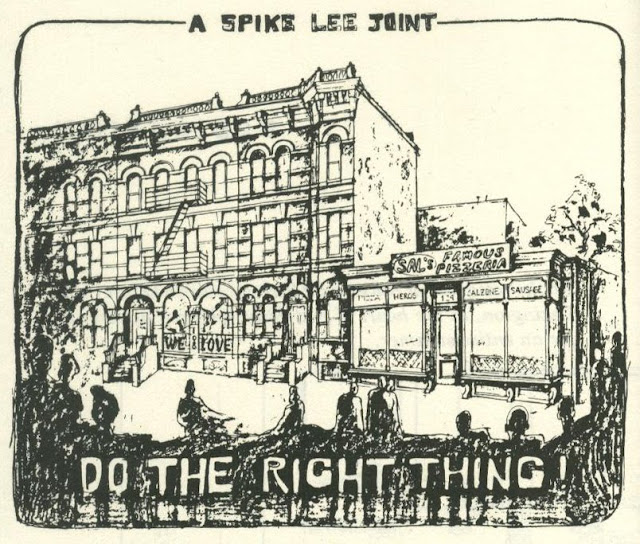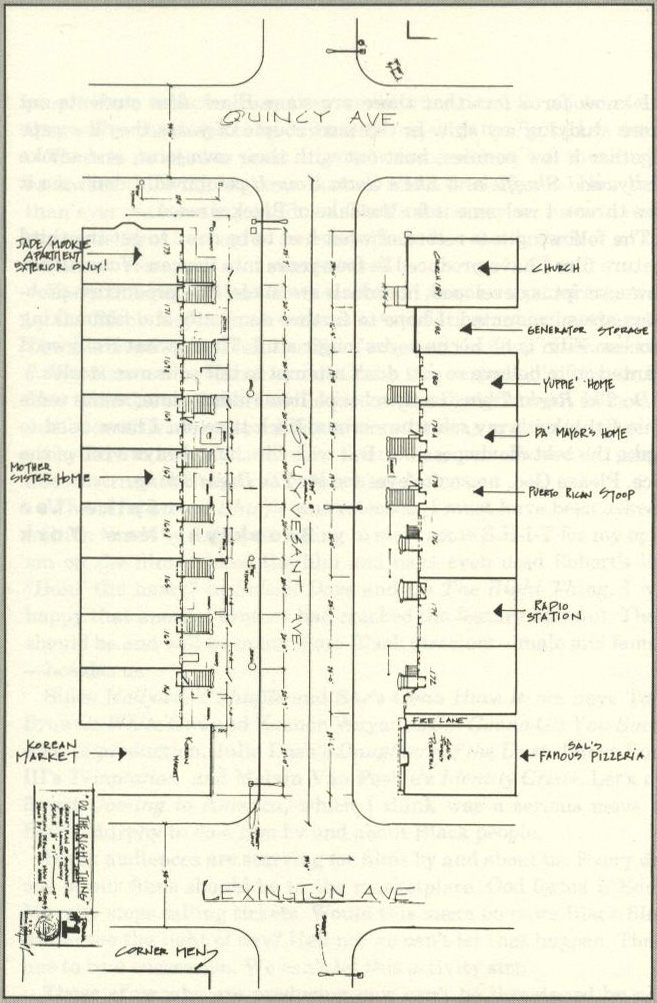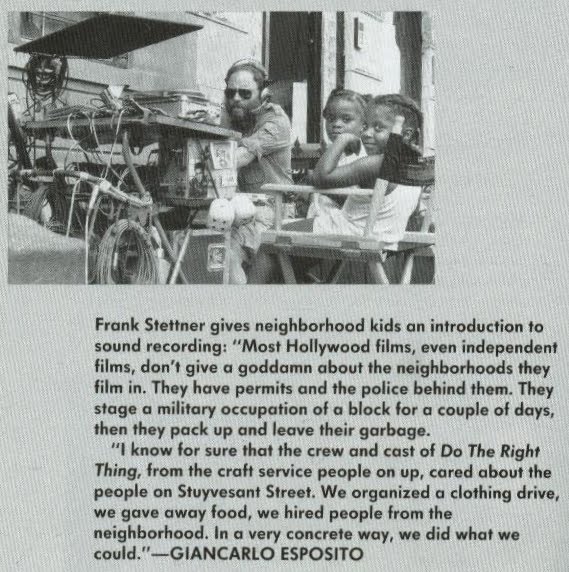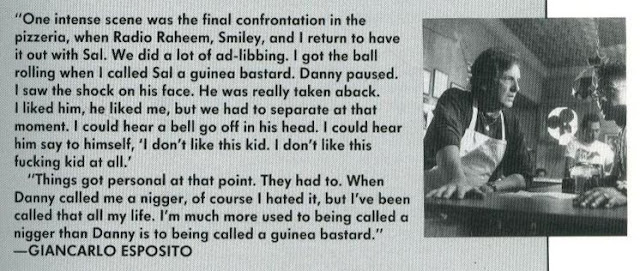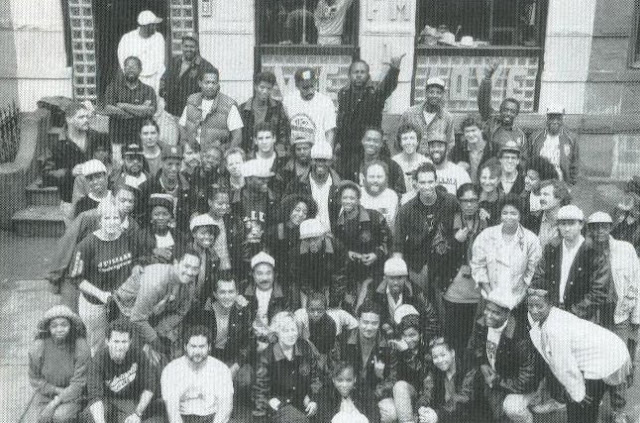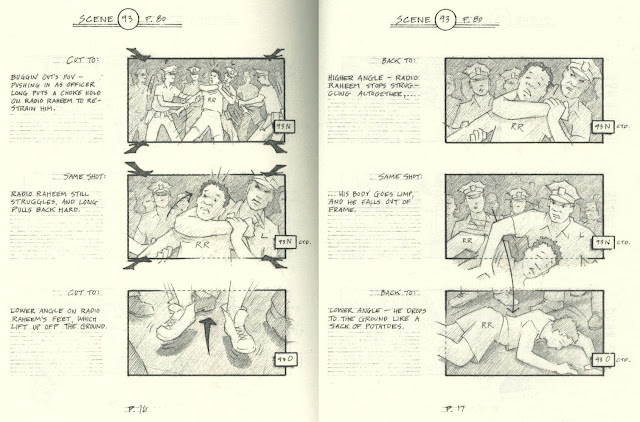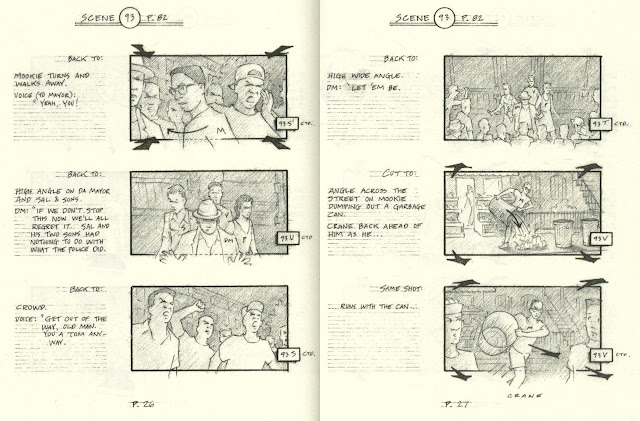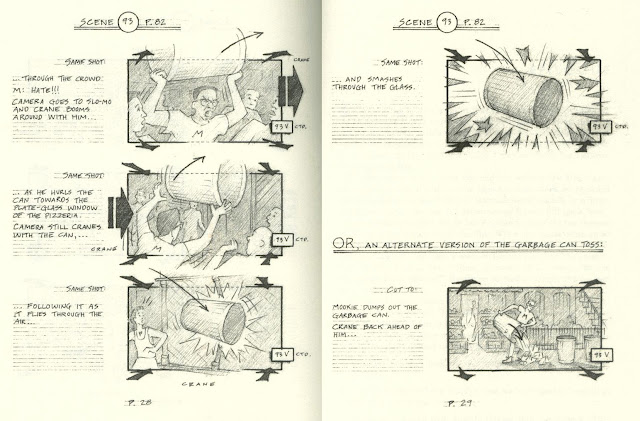!['Hey, the Robot from Fox NFL Broadcasts, what's your fucking deal?']() |
| The helmeted villain with no name attempts to trim Mike's bangs. |
Every Wednesday in "5-Piece Cartoon Dinner," I dine on five of the week's most noteworthy animated cable shows that are found outside my Adult Swim comfort zone. There will be no new columns this week and next week due to the holidays and the lack of first-run programming (only Tron: Uprising
and Motorcity
are first-run because Disney XD chose to burn off the rest of their episodes over the holidays). In a special year-end edition of "5-Piece Cartoon Dinner," here are previous reviews of five of my favorite non-Adult Swim cable cartoon episodes from May to December 2012.Motorcity, "Power Trip" (from May 11, 2012)Motorcity, the only one out of the five cartoons this week that's not based on a superhero comic for a change, is only two episodes in, and this unlikely collabo between Disney and the not-so-family-friendly Titmouse animation studio (of
Metalocalypse and
Freaknik: The Musical fame) is already the most inventive and thrilling of the five. It's not a superhero show, yet it's dealing with questions about heroism (and even activism) more interestingly than most cartoons that are actual superhero shows.
In
Motorcity's future setting, the socio-economical punching bag that is Detroit has been divided by greedy developer Abraham Kane (
Batman: The Animated Series and
Metalocalypse vocal MVP Mark Hamill) into two sections, the sparkling-clean, EPCOT-like Detroit Deluxe for the city's most affluent inhabitants and Motorcity, a subterranean ghetto that Kane is plotting to completely bulldoze. Teenage gearhead Mike Chilton (Reid Scott, currently appearing on HBO's
Veep as the conceited douche on VP Selina Meyer's staff) has banded together with cowardly hacker and best friend Chuck (Nate Torrence), industrial spy Julie (Kate Micucci) and mechanics Dutch (Kel Mitchell), Texas (Jess Harnell) and
Goat Jacob (Brian Doyle-Murray) to prevent Kane and his Shockbots from wiping out Motorcity. These tech-savvy rebels call themselves the Burners. If an older Phineas and Ferb joined Dominic Toretto's crew from the
Fast and the Furious movies and then were all forced to live in a dystopic ghetto of the future, it would look something like the Burners.
To borrow a line from
the infamous Super Bowl XLVI Chrysler ad where
Clint Eastwood big-upped the Detroit auto industry, now Motorcity is fighting again. But will Kane succeed in turning the Burners and the people of Motorcity against Mike, who, like Jacob, used to work for KaneCo? Will the fog, division, discord and blame make it hard for the Burners to see what lies ahead?
Even though
Motorcity must have been created by Titmouse honcho
Chris Prynoski long before the Occupy movement began (and judging from how much work Titmouse put into making the show's visuals look amazing, it had have to been created that long ago) and Prynoski is more concerned with high-octane action than political allegory, it's hard to ignore how similar the Burners' opposition to Kane is to the struggles of us 99 Percenters. It's about time Occupy protesters got an animated show they can root for and embrace--and of course, watch while being camped out between protests, most likely through Burners-style illegal means that would make Disney's blood boil.
Speaking of Disney, how the hell did a show with a clear disdain for EPCOT-like things manage to get Disney's approval and make it on to a Disney-owned channel?
"When I asked Prynoski about this [satirical] aspect of
Motorcity," wrote Jim Hill in
his article about Motorcity, "all Chris could do in response was laugh and then say 'I don't think I'm allowed to comment on that. But I will say that you're a very perceptive fellow.'"
For a long time, I found it difficult to get over Cartoon Network's cancellation of the Titmouse-produced
Megas XLR, which, like
Motorcity, had a bunch of teenage gearheads as the heroes (instead of souped-up hot rods, their ride was a giant robot from the future). I think I'm finally over it.
Motorcity is a great substitute, and in some ways, it's an even better show. Sure, there aren't as many amusing pop culture reference gags on
Motorcity as there were on
Megas XLR, which, for instance, regularly ridiculed MTV for cancelling the Titmouse cult favorite
Downtown by destroying a "PopTV" sign in every episode (Roth, a robot named after car customizer Ed "Big Daddy" Roth, and a shout-out to
Admiral Ackbar's "It's a trap!" line from Hamill's
Star Wars past are as reference-y as
Motorcity gets). But the Burners are more interesting characters (I especially enjoyed the matter-of-fact way the "Battle for Motorcity" premiere episode revealed that Julie is Kane's daughter) and more fallible heroes than
Megas XLR's Coop, who always triumphed over the Glorft at the end of each episode despite leveling most of New Jersey in the process. On
Megas XLR, the destruction of Jersey was a running gag, but on
Motorcity, the impact the Burners' battles against Kane have on the fragile ghetto they call home is treated a little more seriously.
This week's "Power Trip" episode, scripted by
Megas XLR co-creator
George Krstic, features a great scene where the Burners brainstorm how to break into the KaneCo Tower and realize why each of their ideas would suck donkey balls. In that comedic scene and in later moments where characters debate over weaponizing an unstable KaneCo energy source, "Power Trip" deals with how heroism sometimes requires compromise, but without getting preachy about it. Mike gets a KaneCo R&D scientist (Jim Cummings) to steal from Kane an energy core, which would result in Kane's evil empire being shut down once and for all. But even though the energy core is too unstable and dangerous for the Burners to keep around in Motorcity, Mike insists on using it as a weapon, and his stance is met with opposition by Chuck and the scientist. The series isn't afraid to show that while Mike is a great leader, he's also an adrenaline junkie, and his recklessness can be a liability for the people he wants to protect.
![The design for Mike's newest ride is rather mechanorexic.]()
In "Battle for Motorcity," the constantly whiny Chuck, who's so squeamish he makes Shaggy from
Scooby-Doo look macho, quickly became the show's most grating character. He's still a whiny crybaby in "Power Trip," but luckily, this second episode gives Chuck more to do than just whine, squeal and activate his ejector seat, and in the scenes where the characters express their hesitancy over handling the energy core, we see why Mike values Chuck as the conscience of the group and why Mike needs him to keep him in check (over on Tumblr, several
Motorcity fans are already shipping
Mike and Chuck as a gay couple, and I wouldn't be surprised if some female viewer somewhere is currently hard at work on her Mike/Chuck slashfic).
I'm making
Motorcity sound like a serious show, but it's far from it. It's as wild a ride as that rollercoaster Phineas and Ferb built in their backyard. Disney and Titmouse may turn out to be the most worthwhile partnership between The Mouse and another animation studio since Disney and some little computer graphics company from the Bay Area.
***
Motorcity, "Vendetta" (from June 19, 2012)Motorcity introduces yet another adversary for the Burners during another solid episode of this finely crafted cartoon, "Vendetta." This time, it's a nameless, red muscle car-driving warrior (Eric Ladin, just recently killed off on
The Killing) in a spiked helmet who looks like a rejected
Tron: Uprising baddie and is referred to in the end credits only as "Red"--although this mystery man's beef is mainly with Burners leader Mike Chilton. On the one-year anniversary of the day Mike severed ties with Abraham Kane, Red emerges from out of nowhere to take revenge on Mike and eliminate him.
In juicy flashbacks that finally explain what Mike did when he was a KaneCo employee, we learn that he was a cadet in Kane's army of soldiers known as the Ultra Elites. The fact that a businessman assembled an army to guard him and do his dirty work shows how psychotic this particular businessman is.
At the height of Donald Trump's still-continuing racist nonsense about President Obama, Lewis Black did
a hilarious Daily Show "Back in Black" segment where he joked that he wants Trump to be the next president because America needs to be run by someone as insane as Muammar Gaddafi and Kim Jong Il. Kane is like a mash-up of Trump's Third World dictator-style craziness and Steve Jobs' technological genius, his dickish treatment of his Apple colleagues and his love of the color white--in the wardrobe and burly body of a douchey gym manager.
Mike was one of Kane's most obedient cadets, and on the day the sinister Detroit Deluxe developer promoted him to lieutenant, he gave Mike his first mission to supervise: the demolition of a Motorcity tenement building. But when Mike discovered that Kane lied to him about the building being abandoned--it was actually still full of tenants inside--he realized Kane's evilness and walked away from his job. Mike was able to save the tenants' lives, but he wasn't able to save their home from the wrecking ball.
!['I'm gonna shove this stick up your ass and turn you into a Popsicle.'--Mike Chilton's original line, banned by Disney XD]()
One of the residents who ended up homeless also happened to be Red, who blames Mike for the loss of his home. As a reminder to Mike of what he failed to save, Red has his armor emblazoned with the dual-triangle insignia that KaneCo marked on the building for demolition. "Vendetta" never really divulges Red's identity (Kane calls him "son" when he presents him with a job offer in the final scene, so I initially thought Red is Kane's son--and therefore, the brother of Burners member Julie--while another theory I had was that he's Mike's blond-haired cadet friend from the flashbacks, but his voice isn't the same as Red's).
Mike asks his new (and rather standoffish) underworld ally,
the Duke of Detroit (Dee Snider), if he knows the whereabouts of Racer X. The Duke has no idea who this mystery man is either, but he's a little more helpful when it comes to the Burners' other current predicament, Kane's robomites, tiny robots that feed on metal and quickly multiply. Julie's father made cars illegal in both Detroit Deluxe and Motorcity, and now he's invented robomites to infest Motorcity and deprive the Burners of their cherished rides, as well as destroy the plumbing and housing in the subterranean city.
The Duke, who's worried that the mites will munch on the cars in his mansion and junkyards, supplies the Burners with a surplus of iron in the form of an inexplicably gigantic cube, which the team uses to lure the wafer-sized bots away from
the Ambassador Bridge, old Detroit's biggest hunk of iron, and other parts of Motorcity. The Burners spray the block of iron with a corrosive oxidizing agent to poison the mites, which frighten the hell out of the Burners' squeaking robot assistant Roth, even though Roth is made mostly of polymer (copped from KaneCo robot parts by Burners tinkerer Dutch) rather than metal. But the mites are nowhere as frightening as the snack baked by older Burners member Jacob to celebrate the one-year anniversary of Mike's conversion to heroism: okra-mayonnaise muffins.
Texas has become
Motorcity's breakout character because of his dumb-jock dialogue (he even refers to himself in the third person like many sports celebrities do), but he isn't always this Keanu-esque Asian jock whose solution for everything is sweet Muay Thai kicks, and he can be quite perceptive when his ego isn't in the way. In this episode, Texas gets to act as a voice of reason when Mike expresses to him his guilt over not having been more aware of Kane's evilness when he worked for him. He tells Mike that his late realization about his tyranny is understandable because a master manipulator like Kane makes it difficult for people to see his true agenda, and then he says, "You've got to stop thinking about what you didn't do and start thinking about what you're doing to save people now."
![Texas speechifies it.]()
![And then...]()
No one in cartoon voice acting does rage quite like Mark Hamill, and while he's terrific as Kane (he was downright menacing when Kane shook Julie around like a rag doll and barked at her in the "Battle for Motorcity" premiere episode), the character has tended to be a one-note villain who does nothing but sneer and rant and lash out at his underlings. (I bet
Motorcity creator Chris Prynoski gave Kane's dumbass underling the name Tooley as a shout-out to both Harley Quinn from Hamill's
Batman: The Animated Series days and the distinctive way Hamill would put the accent on "Har-LEEEY!!!" whenever The Joker would bark at her. I've noticed Hamill, who's been reunited with his
Batman voice director Andrea Romano on this show, does that same accent thing when he yells "Too-LEEEY!!!")
But in the flashbacks in "Vendetta," Hamill gets to tone Kane down a bit and show a more
subtle and fatherly side to him, which illustrates Texas' later point about Kane being such an effective enemy because of how he lured to his side good people like Mike, Jacob and the R&D scientist from
"Power Trip." I also like how in the flashbacks, "Vendetta" writer John O'Bryan doesn't hold back in turning Kane into the cruelest Disney villain since Scar from
The Lion King. Ordering the demolition of a tenement building with residents still inside and without even letting them know that they should evacuate? Wow, that's as vile as an okra-mayonnaise muffin.
***
Adventure Time, "Princess Cookie" (from June 26, 2012)My favorite animation voice guest shot of the week belongs to Donald Faison as the title character in "Princess Cookie,"
Adventure Time's latest short. The former
Scrubs star's enjoyable role as a misunderstood and orphaned cookie who wants to be a princess like Bubblegum (Hynden Walch) despite what society tells him out-weirds anything J.D.'s overactive imagination ever dreamed up about Turk, including even
that half-J.D./half-Turk creature straight out of the glubbed-up transporter in the
Fly movies.
I also got a kick out of hearing the normal speaking voice of Maria Bamford, who's a frequent vocal presence on
Adventure Time, instead of one of her various other voices. Here, Bamford turns up as the voice of Princess Cookie's accomplice Chipolina. (The reactions on Tumblr to "Princess Cookie" have been fascinating. They've ranged from teens who praise the episode and interpret it as a metaphor for either
transgender people's struggles or
at-risk youth to LGBT viewers who bristle at the portrayal of Princess Cookie as
a violent and suicidal LGBT character. And then there are viewers who don't see sexual orientation or gender or race in Faison's character.
They just see a cookie.)
Because
Adventure Time is such an unpredictable ride, what starts out as a spoof of hostage-movie tropes--with Jake (John DiMaggio), the most laid-back hostage negotiator in screen history, talking Princess Cookie out of holding the Candy Kingdom citizens hostage inside a convenience store--morphs quite smoothly into one of the show's most affecting installments. Without having Jake spell things out to the screen like Spidey constantly does in the latest anvillicious
Ultimate Spider-Man episode, "Princess Cookie" conveys a subtle message to the misfits in the audience that even though it feels like they're alone in the world, they won't be--whether they're teenage children of immigrants who don't want to be handcuffed to the boring careers that their strict parents have assigned to them or LGBT teens who refuse to be ostracized or mistreated by bullies or homophobic parents. Somewhere, there's a place where their misfit nature will be celebrated and embraced.
***
Tron: Uprising, "Isolated" (from July 10, 2012)Green Lantern: The Animated Series and
Transformers Prime have been more satisfying than their much-maligned live-action counterparts, and
Tron: Uprising has joined them as another example of an animated show that's superior to its live-action counterpart, thanks to its best episode yet, "Isolated." The story puts the spotlight on the animated
Tron: Legacy prequel's most compelling creation so far: Paige, a lieutenant in evil General Tesler's army whom Tesler has assigned the task of hunting down Beck, a.k.a. the masked Renegade.
The straight-arrow Beck's evolution from mechanic to hero has been a less interesting arc than Paige's desperate bid for her ruthless general's respect, which has put her in competition with Tesler's supercilious right-hand man Pavel (Paul Reubens) ("Isolated"'s "previously on" segment amusingly counterpoints narrator Tricia Helfer's recap--"Tesler rewards Paige's hard work with praise"--with a montage of clips of Tesler and Pavel both belittling Paige). "Isolated" reveals why Paige chose to work for Tesler and ties her backstory to Quorra (Olivia Wilde, reprising the most interesting character from
Tron: Legacy).
Trapped on a slowly disintegrating island with Beck and forced to work with her enemy (and if
Tron: Uprising lasts past a season, inevitable love interest) to find a way out before the rock sinks into the sea, Paige flashes back to her time as a hospital medic. Back then, Paige dabbled in composing instrumental music, even though as another character told her, she's not "programmed" to be a musician.
Her instrument reminds me of the Tenori-on used by electro artist Little Boots in the viral video for her track "Stuck on Repeat":
(Someone on
the Tron-Sector fansite forums noted that Paige's instrument is a variation on
the Tonematrix, a sweet music-making tool that will prevent you from getting anything else done for a couple of hours.)
Paige was once encouraged to pursue music by Quorra, whom she briefly befriended when Quorra brought in to the medical center Ada (Meagan Holder), a friend of Quorra's who was injured while escaping
the genocidal purge of the ISOs that was ordered by Grid dictator Clu. Introduced in
Tron: Legacy, the ISOs were a race of advanced beings who were unique in The Grid for not being programs and were an accidental but miraculous creation by software genius Kevin Flynn.
Clu, Flynn's evil clone, resented his creator's attachment to the ISOs and considered their humanity an imperfection, so he derezzed all of them, except for a few ISOs who managed to survive Clu's attacks, including Ada and Quorra, who, to evade capture, hid ISO markings on her skin from the medics. Paige's greatest quality as a soldier--her loyalty to whoever is her superior--is also the reason for her tragic flaw: her inability to question anything that appears to be wrong, whether it's whatever lie Tesler tells her or the lies about the "crooked and dangerous" nature of the ISOs that Clu's forces have spread across The Grid.
Paige too easily accepted as truths those lies about the ISOs, so when she spotted Quorra's markings, she considered snitching on Quorra's whereabouts to the authorities. However, Paige didn't go through with the snitching. Her medical center co-workers did. Later, when Paige awoke from being knocked out by Quorra during her escape from Tesler's guards (she believes that Paige betrayed her, so I'm betting Wilde will resurface later in the season for Quorra's inevitable battle against Paige), she discovered her medical center staff was massacred.
The aftermath of the attack was where Paige first encountered Tesler, who told her that her co-workers were derezzed by Quorra and Ada and offered her a spot in his army as a way to seek her revenge. Paige doesn't know that Tesler lied to her and was the one who derezzed her co-workers right after they reported Quorra and Ada to him (he deemed any program who came into contact with ISOs to be too "contanimated" by them).
Wilde's guest shot is a treat for those of us who enjoyed her performance in
Tron: Legacy. Quorra's love for the works of Jules Verne, her curiosity about the world outside The Grid and her wish to see an actual sunrise helped keep the film from becoming a way-too-chilly-and-dull sci-fi actioner, and even though those character touches bordered on
Manic Pixie Dream Girl Syndrome, Wilde did a nice job bringing to life those aspects of her character. In "Isolated," Paige's music brings out in Quorra the same kind of curiosity she expressed about Verne and the Flynn family's non-digital world.
![ISO horny.]() |
| Olivia Wilde vamps it up as Jordan in the Disney remake of The Great Gatsby. |
An even more surprising credit in "Isolated" than Wilde's name belongs to André Bormanis, who scripted the episode and whose name is familiar to those of us who pay attention to the credits of sci-fi/fantasy shows--he's a veteran of
Legend of the Seeker and the
Star Trek spinoffs. That era of
Trek when Bormanis served as a writer and science consultant can be a chore to watch because of the later spinoffs' overreliance on the same kind of impenetrable technobabble that makes the first
Tron film a chore to watch too.
Bormanis takes a crucial and less irritating element of the writing on those
Trek shows since the '60s--incorporating past and present real-world issues into the
Trek heroes' missions--and brings it to "Isolated." The racially tinged treatment of the ISOs parallels both the harsh treatment of illegal immigrants in Arizona and the persecution of Jews, right down to the ISOs' markings (although those are birthmarks instead of prisoner number tattoos imprinted by their captors).
If you derezzed the virtual setting of The Grid and the terms "program," "ISO" and "derezzed," the flashback portion of "Isolated" could easily be a story about a medic in a Nazi-occupied part of Europe who discovers the patient he's befriended is a Jewish refugee and is faced with the dilemma of turning the refugee in to the authorities. The episode's final scene poignantly shows Paige clinging to one of the few remnants of both her old life and her humanity, as she secretly reactivates the old melody that used to automatically play on her instrument. All this is pretty weighty stuff for a Disney XD show.
Both "Isolated" and last week's episode,
"Identity," which deepened the previously boring character of Tron himself ("Tron isn't a character, he's an impossibly virtuous program,"
complained the A.V. Club about the 1982 movie's screenplay in 2010), have shown how far the
Tron franchise has come from the flat writing and convoluted, barely-comprehensible-when-you-were-a-kid gibberish about programs and their "users" that characterized the first movie.
Tron is evolving into a more relatable and mature--as well as far less technobabble-plagued and far less alienating--franchise. It's like the live-action
Star Wars franchise in reverse.
***
![Linda Cardellini in 2011, far from freaky or geeky]() |
| Linda Cardellini |
Gravity Falls, "The Inconveniencing" (from July 17, 2012)Gravity Falls' "Inconveniencing" episode shows why getting former
Freaks and Geeks star Linda Cardellini to voice the Pines twins' teen friend Wendy was brilliant casting, and it makes me wish Cardellini did more animation (other than this series and
a recent Regular Show guest shot). On Paul Feig and Judd Apatow's classic show, Cardellini played Lindsay Weir, an unhappy math nerd who ditched the uptight and competitive mathlete crowd and found kindred spirits in her new friends, James Franco's underachieving burnout Daniel Desario and his pack of mischievous and much-maligned "freaks."
This time, Cardellini plays the charismatic Daniel figure who brings into her crowd a couple of newbies: Mabel and Dipper, who's got a crush on the older Wendy and lies about being 13 instead of his actual age of 12 to attempt to impress her. Because there are much less things for teens to do on Friday night in a small and secluded town like Gravity Falls, Oregon than there are in suburbs like the Detroit burb where
Freaks and Geeks was set (and also because this is a TV-Y7-rated Disney Channel show, so the drugs and sex are kept off-screen), Wendy and her friends, including sullen musician/wanna-be artist Robbie (T.J. Miller), Thompson (episode co-writer Michael Rianda) and Tambry (Jessica DiCicco), break into the Dusk 2 Dawn, an abandoned convenience store that's rumored to be haunted. Dipper and Mabel tag along and discover the wonders of food fights and purloining junk food without paying for it and getting caught (even though it's 17-year-old junk food, which, judging from the kids' unperturbed reactions, doesn't taste like it's 17 years old).
The kids' fun at the Dusk 2 Dawn comes to an abrupt end when they realize the rumors about its history of corpses and ghosts are true. Chalk outlines of corpses are uncovered, and the haunted store traps the teens inside and attacks them one by one (Tambry gets sucked into the smartphone she won't stop texting into, while Thompson becomes trapped inside the screen of a "Dancy Pants Revolution" machine). The elderly couple (Ken Jenkins from
Scrubs and April Winchell) that ran the Dusk 2 Dawn died 17 years ago inside the store from a simultaneous heart attack caused by their intense hatred of rowdy teen customers and their "newfangled rap music" (which contained offensive lyrics like "Homework's wack, and so are rules/Tuckin' in your shirt's for fools!"), so the owners' ghosts are retaliating against any teen who trespasses.
The highlights of "The Inconveniencing" include that amusing little parody of clean-cut '90s rap, the novel placement of
Poltergeist-style gags in a 7-Eleven setting and the recurring acknowledgement of the crappy economy without directly referencing it in dialogue (Grunkle Stan's Mystery Shack gift shop doesn't seem to be attracting any customers). But I wish the end credits' hidden messages weren't merely snatches of earlier dialogue (by the way, this week's cryptogram, "rqzdugv drvklpd!," is "Onwards, Aoshima!," which Mabel said to her flying dolphin during her sugar-induced hallucination) and were actual clues about something--like that hot dog-shaped shadow hovering over Wendy's lawn chair on the Mystery Shack rooftop during "The Inconveniencing"'s cold open.
Does that noisy flying shadow have anything to do with that muffin-shaped explosion Robbie spray-painted on the town watertower? Did that explosion come from a UFO Robbie saw? And why aren't there more Disney cartoons that make their viewers think and play detective like this?
***
Time to evaluate the cartoons I've discussed from May to December 2012, based on all the episodes I've seen of each cartoon (using
Entertainment Weekly-style letter grade averages and placed in order from worst to best).
23.
Ultimate Spider-Man: C
22.
Ben 10: Omniverse: C
21.
Teenage Mutant Ninja Turtles: C
20.
Kung Fu Panda: Legends of Awesomeness: C
19.
The Amazing World of Gumball: C+
18.
Iron Man: Armored Adventures: B-
17.
ThunderCats: B-
16.
Transformers Prime: B-
15.
Randy Cunningham: 9th Grade Ninja: B-
14.
Star Wars: The Clone Wars: B-
13.
The Legend of Korra: B
12.
Kaijudo: Rise of the Duel Masters: B
11.
The Avengers: Earth's Mightiest Heroes: B
10.
Dan Vs.: B
9.
Green Lantern: The Animated Series: B+
8.
Young Justice: Invasion: B+
7.
Dragons: Riders of Berk: B+
6.
Scooby-Doo! Mystery Incorporated: B+
5.
Tron: Uprising: B+
4.
Gravity Falls: A-
3.
Motorcity: A
2.
Adventure Time: A
1.
Regular Show: A
More reruns next Wednesday.














































































































































































































